国际财务管理第十三章
- 格式:ppt
- 大小:135.50 KB
- 文档页数:42

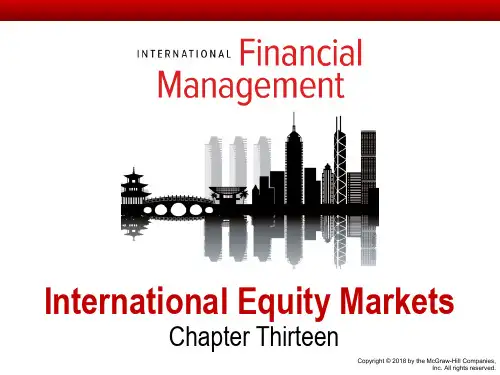

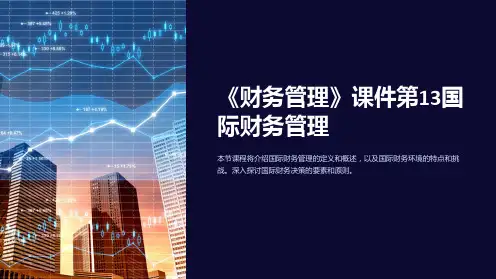
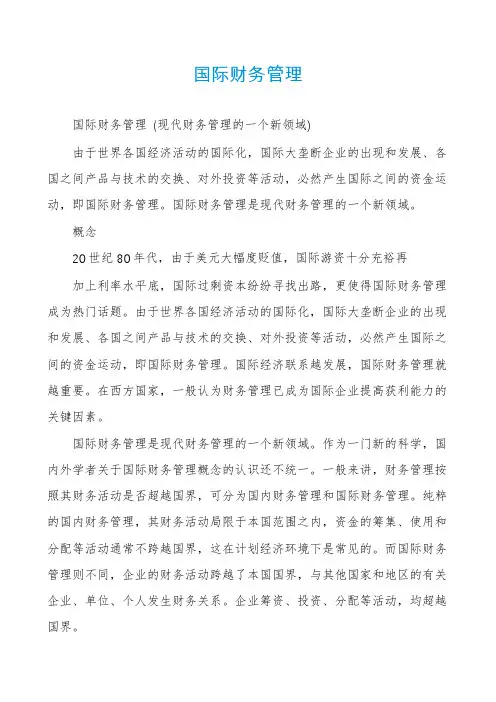
国际财务管理国际财务管理(现代财务管理的一个新领域)由于世界各国经济活动的国际化,国际大垄断企业的出现和发展、各国之间产品与技术的交换、对外投资等活动,必然产生国际之间的资金运动,即国际财务管理。
国际财务管理是现代财务管理的一个新领域。
概念20世纪80年代,由于美元大幅度贬值,国际游资十分充裕再加上利率水平底,国际过剩资本纷纷寻找出路,更使得国际财务管理成为热门话题。
由于世界各国经济活动的国际化,国际大垄断企业的出现和发展、各国之间产品与技术的交换、对外投资等活动,必然产生国际之间的资金运动,即国际财务管理。
国际经济联系越发展,国际财务管理就越重要。
在西方国家,一般认为财务管理已成为国际企业提高获利能力的关键因素。
国际财务管理是现代财务管理的一个新领域。
作为一门新的科学,国内外学者关于国际财务管理概念的认识还不统一。
一般来讲,财务管理按照其财务活动是否超越国界,可分为国内财务管理和国际财务管理。
纯粹的国内财务管理,其财务活动局限于本国范围之内,资金的筹集、使用和分配等活动通常不跨越国界,这在计划经济环境下是常见的。
而国际财务管理则不同,企业的财务活动跨越了本国国界,与其他国家和地区的有关企业、单位、个人发生财务关系。
企业筹资、投资、分配等活动,均超越国界。
企业参与国际市场的竞争,是市场经济环境下不可避免的。
我们认为,国际财务管理就是对国际企业财务活动的管理。
国际企业是相对于纯粹的国内企业而言,它泛指一切超越国界从事生产经营活动的企业,包括跨国公司、进出口企业、外商投资企业等。
国际财务管理重点1.简述国际财务管理定义的各种观点。
(1)国际财务管理是世界财务管理——研究能在全世界范围内普遍使用的原理方法,使世界各国的财务管理逐渐走向统一。
(2)国际财务管理是比较财务管理——比较不同国家在组织财务收支处理财务关系方面的差异,以便在解决国际间财务问题是不把自己国家的原则强加给对方,求同存异互惠互利。
(3)国际财务管理是跨国公司财务管理——研究跨国公司在组织财务活动处理财务关系时所遇到的特殊问题。
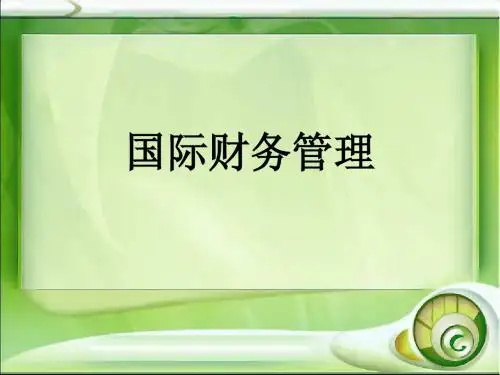
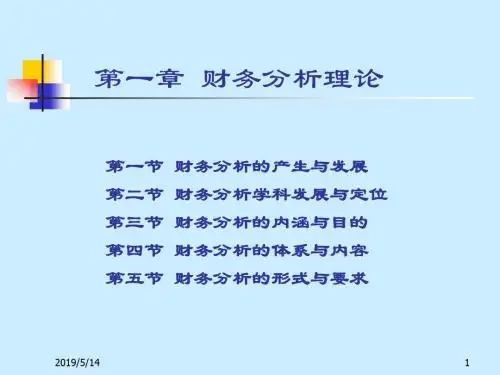
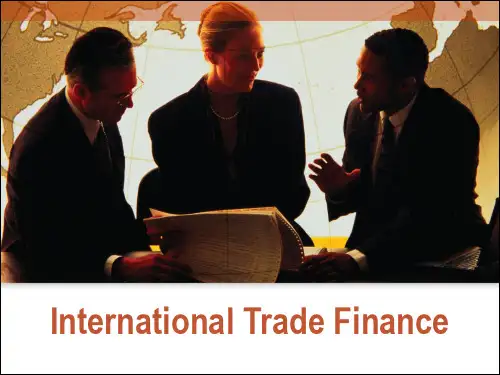
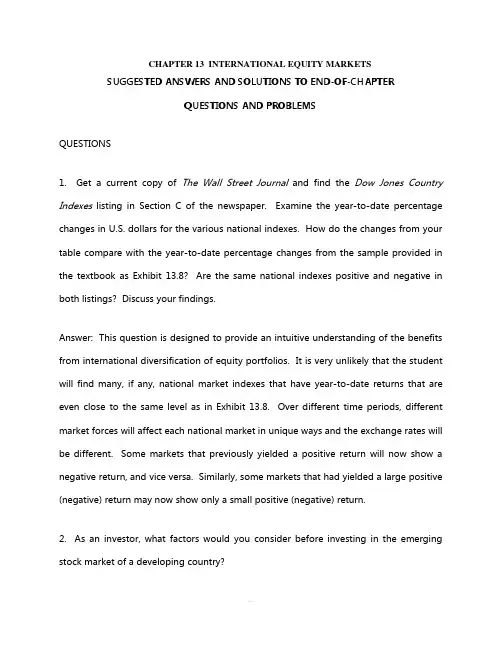
CHAPTER 13 INTERNATIONAL EQUITY MARKETSSUGGESTED ANSWERS AND SOLUTIONS TO END-OF-CHAPTERQUESTIONS AND PROBLEMSQUESTIONS1. Get a current copy of The Wall Street Journal and find the Dow Jones Country Indexes listing in Section C of the newspaper. Examine the year-to-date percentage changes in U.S. dollars for the various national indexes. How do the changes from your table compare with the year-to-date percentage changes from the sample provided in the textbook as Exhibit 13.8? Are the same national indexes positive and negative in both listings? Discuss your findings.Answer: This question is designed to provide an intuitive understanding of the benefits from international diversification of equity portfolios. It is very unlikely that the student will find many, if any, national market indexes that have year-to-date returns that are even close to the same level as in Exhibit 13.8. Over different time periods, different market forces will affect each national market in unique ways and the exchange rates will be different. Some markets that previously yielded a positive return will now show a negative return, and vice versa. Similarly, some markets that had yielded a large positive (negative) return may now show only a small positive (negative) return.2. As an investor, what factors would you consider before investing in the emerging stock market of a developing country?Answer: An investor in emerging market stocks needs to be concerned with the depth of the market and the market’s liqui dity. Depth of the market refers to the opportunities to invest in the country. One measure of the depth of the market is the concentration ratio of a country’s stock market. The concentration ratio frequently is calculated to show the market value of the ten largest stock traded as a fraction of the total market capitalization of all equities traded. The higher the concentration ratio, the less deep is the market. That is, most value is concentrated in only a few companies. While this does not necessarily imply that the largest stocks in the emerging market are not good investments, it does, however, suggest that there are few opportunities for investment in that country and that proper diversification within the country may be difficult. In terms of liquidity, an investor would be wise to examine the market turnover ratio of the country’s stock market. High market turnover suggests that the market is liquid, or that there are opportunities for purchasing or selling the stock quickly at close to the current market price. This is important because liquidity means you can get in or out of a stock position quickly without spending more than you intended on purchase or receiving less than you expected on sale.3. Compare and contrast the various types of secondary market trading structures.Answer: There are two basic types of secondary market trading structures: dealer and agency. In a dealer market, the dealer serves as market maker for the security, holding an inventory of the security. The dealer buys at his bid price and sells at his asked price from this inventory. All public trades go through the dealer. In an agency market,public trades go through the agent who matches it with another public trade. Both dealer and agency markets can be continuous trade markets, but non-continuous markets tend to be only agency markets. Over-the-counter trading, specialist markets, and automated markets are types of continuous market trading systems. Call markets and crowd trading are each types of non-continuous trading market systems. Continuous trading systems are desirable for actively traded issues, whereas call markets and crowd trading offer advantages for smaller markets with many thinly traded issues because they mitigate the possibility of sparse order flow over short time periods.4. Discuss any benefits you can think of for a company to (a) cross-list its equity shares on more than one national exchange, and (b) to source new equity capital from foreign investors as well as domestic investors.Answer: A MNC that has a product market presence or manufacturing facilities in several countries may cross-list its shares on the exchanges of these same countries because there is typically investor demand for the shares of companies that are known within a country. Additionally, a company may cross-list its shares on foreign exchanges to broaden its investor base and therefore to increase the demand for its stock. An increase in demand will generally increase the stock price and improve its market liquidity. A broader investor base may also mitigate the possibility of a hostile takeover. Additional, cross-listing a company’s shares establishes name recognition and thus facilitates sourcing new equity capital in these foreign capital markets.5. Why might it be easier for an investor desiring to diversify his portfolio internationally to buy depository receipts rather than the actual shares of the company?Answer: A depository receipt can be purchased on the investor’s domestic exchange. It represents a package of the underlying foreign security that is priced in the investor’s local currency and in a trading range that is typical for the investor’s marketplace. The investor can purchase a depository receipt directly from his domestic broker, rather than having to deal with an overseas broker and the necessity of obtaining foreign funds to make the foreign stock purchase. Additionally, dividends are received in the local currency rather than in foreign funds that would need to be converted into the local currency.6. Why do you think the empirical studies about factors affecting equity returns basically showed that domestic factors were more important than international factors, and, secondly, that industrial membership of a firm was of little importance in forecasting the international correlation structure of a set of international stocks?Answer: While national security markets have become more integrated in recent years, there is still a tremendous amount of segmentation that brings about the benefit to be derived from international diversification of financial assets. Monetary and fiscal policies differ among countries because of different economic circumstances. The economic policies of a country directly affect the securities traded in the country, and they will behave differently than securities traded in another country with other economic policies being implemented. Hence, it is not surprising that domestic factors are foundto be more important than international factors in affecting security returns. Similarly, industrial activity within a country is also affected by the economic policies of the country; thus firms in the same industry group, but from different countries, will not necessarily behave the same in all countries, nor should we expect the securities issued by these firms to behave alike.PROBLEMS1. On the Milan bourse, Fiat stock closed at EUR5.84 per share on Thursday, March 3, 2005. Fiat trades as and ADR on the NYSE. One underlying Fiat share equals one ADR. On March 3, the $/EUR spot exchange rate was $1.3112/EUR1.00.a. At this exchange rate, what is the no-arbitrage U.S. dollar price of one ADR?b. By comparison, Fiat ADRs closed at $7.61. Do you think an arbitrage opportunity exists?Solution:a. The no-arbitrage ADR U.S. dollar price is: EUR5.84 x $1.3112 = $7.66.b. It is unlikely that an arbitrage opportunity exists after transaction costs. Additionally the slight difference in prices is likely accounted for by a difference in information contained in prices since the ADR market in New York closed several hours after the Milan bourse.2. If Fiat ADRs were trading at $7 when the underlying shares were trading in Milan at EUR5.84, what could you do to earn a trading profit? Use the information in problem 1, above, to help you and assume that transaction costs are negligible.Solution: As the solution to problem 1 shows, the no-arbitrage ADR U.S. dollar price is $7.66. If Fiat ADRs were trading at $7, a wise investor would buy the relatively undervalued ADRs. Since the ADRs are a derivative security, one would expect the ADRs to increase in price from $7 to $7.66. Assuming this happens, the position could be liquidated for a profit of $7.66 - $7.00 = $0.66 per ADR.MINI CASE: SAN PICO’S NEW STOCK EXCHANGESan Pico is a rapidly growing Latin American developing country. The country is blessed with miles of scenic beaches that have attracted tourists by the thousands in recent years to new resort hotels financed by joint ventures of San Pico businessmen and moneymen from the Middle East, Japan, and the United States. Additionally, San Pico has good natural harbors that are conducive for receiving imported merchandise from abroad and exporting merchandise produced in San Pico and other surrounding countries that lack access to the sea. Because of these advantages, many new businesses are being started in San Pico.Presently, stock is traded in a cramped building in La Cobijio, the nation’s capital. Admittedly, the San Pico Stock Exchange system is rather archaic. Twice a day an official of the exchange will call out the name of each of the 43 companies whose stock trades on the exchange. Brokers wanting to buy or sell shares for their clients then attempt to make a trade with one another. This crowd trading system has worked well for over one hundred years, but the government desires to replace it with a new modern system that will allow greater and more frequent opportunities for trading in each company, and will allow for trading the shares of the many new start-up companies that are expected to trade in the secondary market. Additionally, the government administration is rapidly privatizing many state-owned businesses in an attempt to foster their efficiency, obtain foreign exchange from the sale, and convert the country to a more capitalist economy. The government believes that it could conduct this privatization faster and perhaps at more attractive prices if it had a modern stock exchange facility where the shares of thenewly privatized companies will eventually trade.You are an expert in the operation of secondary stock markets and have been retained as a consultant to the San Pico Stock Exchange to offer your expertise in modernizing the stock market. What would you advise?S uggested Solution to San Pico’s New Stock ExchangeMost new and renovated stock exchanges are being established these days as either a partially or fully automated trading system. A fully automated system is especially beneficial for a small to medium size country in which there is only moderate trading in most issues. Such a system that deserves special note is the continuous National Integrated Market system of New Zealand. This system is fully computerized and does not require a physical structure. Essentially, all buyers and sellers of a stock enter through their broker into the computer system the number of shares they desire to buy or sell and their required transaction price. The system is updated constantly as new purchase or sale orders are entered into the system. The computer constantly searches for a match between buyer and seller, and when one is found a transaction takes place. This type of system would likely serve San Pico’s needs very well. There is existing technology to implement, the bugs have been worked out in other countries, and it would satisfy all the demands of the San Pico government and easily accommodate growth in market activity.。
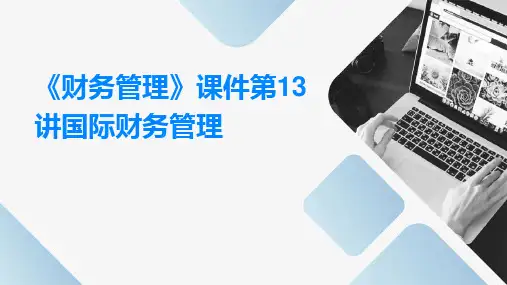
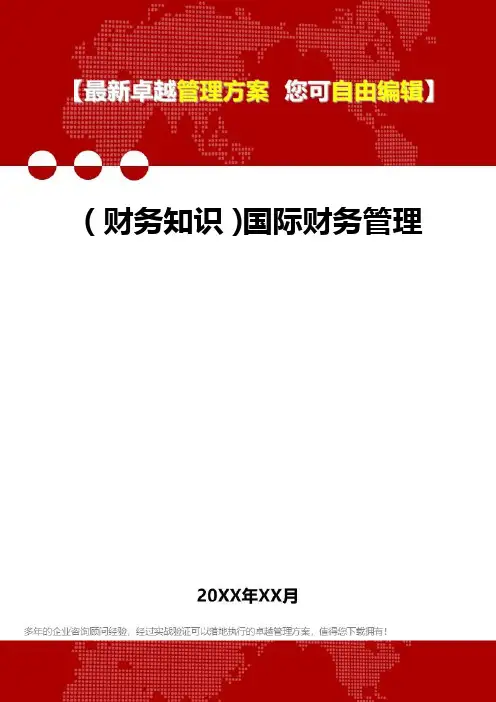
(财务知识)国际财务管理第一部分自学指导第1章:国际财务管理总论一.主要内容1.国际财务管理的概念。
2.国际财务管理的目标。
3.国际财务管理的发展。
二.重点1.国际财务管理基本概念。
2.国际财务管理特点。
3.国际财务管理目标。
三.难点1.国际财务管理目标。
2.国际财务管理特点。
第2章:国际财务管理环境一.主要内容1.国际财务管理环境概述2.国际财务管理的经济环境。
3.国际财务管理社会环境。
二.重点1.国际财务管理环境的概念。
2.研究国际财务管理环境的意义。
3.经济环境对国际财务管理。
4.社会环境对国际财务管理。
三.难点1.国际财务管理环境的概念。
2.环境对国际财务管理影响。
第3章:国际企业的财务分析一.主要内容1.财务分析概述。
2.财务比率分析。
3.财务分析的国际比较。
二.重点1.财务分析基本概念与程序。
2.判别财务指标优劣标准。
3.各种财务指标计算与运用。
4.各国财务比率差异比较。
三.难点1.财务分析程序。
2.在财务分析中正确运用有关标准。
3.财务分析指标运用。
第4章:外汇市场一.主要内容1.外汇市场概论。
2.即期外汇市场。
3.远期外汇市场。
4.货币期货市场。
5.货币期权市场。
二.重点1.外汇市场的概念及其分类、功能。
2.即期和远期外汇市场概念。
3.即期外汇交易的报价。
4.远期外汇合约、远期外汇合约。
5.货币期货概念、市场组成、货币期货合约。
6.货币期权概念、交易类型、货币期权合约三.难点1.外汇市场功能。
2.远期升水与贴水。
3.远期外汇交易报价。
4.货币期货交易功能。
5.货币期权的估价。
第5章:汇率预测一.主要内容1.汇率概述。
2.汇率决定理论。
3.汇率预测的基本方法。
二.重点1.汇率及其标价法基本概念。
2.汇率升值与贬值。
3.购买力平价说、国际费雪效应、利率平价说等理论基本观点。
4.汇率预测基本方法。
三.难点1.利用汇率计算货币的升值与贬值。
2.汇率决定理论基本观点理解。
第6章:外汇风险管理一.主要内容1.外汇风险的种类。
《国际财务管理》第十三章:国际营运资金管理(选择,判断)1.以下属于净营运资金的是()A,现金 B,短期证券 C,应收账款 D,流动资产减去流动负债的净额答案:D2.营运资金的存量管理的目的是()A,使现金余额,应收账款和存货处于最佳的持有水平 B,使现金余额,应收账款和存货处于最大的持有水平C,使现金余额,应收账款和存货处于最小的持有水平 D,使现金余额,应收账款和存货处于零的持有水平答案:A3.国际企业现金管理的根本目标是()A,确定投资于现金的最佳水平 B,使企业持有的现金数量最大化 C,保证充足的现金 D,多项投资答案:A4.如果两家公司有相互交易,可以用某种固定汇率把双方间的交易额抵消结算这叫()A,多边净额核算 B,单边净额核算 C,双边净额核算 D,掉期交易答案:C5.应收账款的数量大小取决因素是()A,赊销额的大小 B,信誉度 C,双方协议 D,市场行情答案:A6.独立顾客的应收账款管理中影响付款条件的因素中最重要的是()A,交易币种的程度 B,信贷条件 C,双方协议 D,信贷标准答案:A7.在国际企业内部应收账款的管理上运用提前或延迟付款,主要经济上的因素是()A,汇率 B,政治不稳定 C,外汇管制 D,货币贬值答案:A8.当跨国成员从事贸易活动时,商品和劳务直接由子公司提供给买方,但有关收支的业务都通过___进行。
A,母公司 B,母公司的开户银行 C,子公司的开户银行 D,再开票中心答案:D9.存货超前购置涉及到的业务成本有()A,通货膨胀的成本 B,货币贬值的成本 C,保险费 D,运输延迟的成本答案:C10.跨国企业的子公司向母公司转移资金的最普遍方式是()A,转移价格 B,特许权费 C,股利汇付 D,服务费答案:C11.用于补偿由母公司或其他子公司供应给该子公司的专门服务的支出叫()A,特许权费 B,管理费 C,劳务费 D,服务费答案:D多项选择题。
1.国际营运资金管理的内容包括()A,存量管理 B,流量管理 C,现金管理 D,货款管理 E,责任管理答案:AB2.国际营运资金管理需考虑的环境因素中对营运资金管理有直接影响的政策是()A,外汇管理 B,税收政策 C,股利汇付的限制 D,跨国公司内部付款的限制 E,转移价格的限制答案:ABCDE3.企业持有现金的动机包括()A,交易动机 B,谨慎动机 C,投机动机 D,盈利动机 E,冒险动机答案:ABC4.国际企业现金管理的方法有()A,现金集中管理 B,多边净额结算 C,短期现金预算 D,多国性现金调度系统 E,双边净额结算答案:ABCD5.现金集中管理的优点有()A,规模经营的优势 B,可以减少费用的支出 C,信息优势 D,全局性优势 E,局部性优势答案:ACD6.国际企业内部的应收账款与独立顾客的应收账款的差别体现在()A,无需考虑资信问题 B,需要考虑资信问题 C,付款时间取决于国际企业的全球性战略 D,付款时间取决于国际企业的商业习惯 E,选择东道国的币种答案:AC7.国际企业内部应收账款的管理技巧包括()A,选择坚挺的货币 B,提前或延迟付款 C,再开票中心的设置 D,应收账款的让售 E,应收账款的贴现答案:BC8.___是存货管理中最须关注的问题。